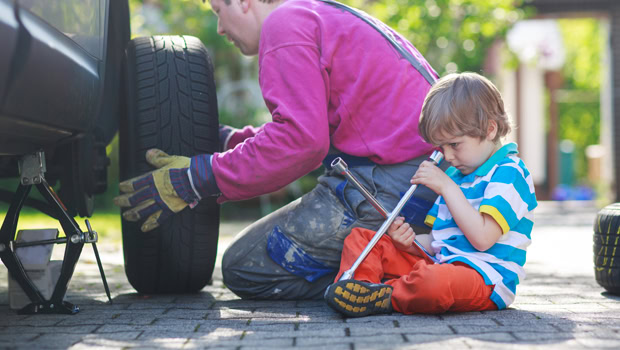
Recently, my 2-year-old son looked at my insulin pump. He had a look on his face that showed he was working through something, and that a question was coming.
He looked at my pump. Then he looked at me. Then he looked back at my pump.
“What’s that, Daddy?” he asked.
I’ve told him many times since I started pump therapy almost a year ago what my pump is, and what it does. So I decided to test him to see if he’s been listening.
“What do you think it is, son?” I asked.
“Daddy’s pump,” he said.
“And what does Daddy’s pump do?”
“Medicine,” he answered immediately.
“And why does Daddy need his medicine?”
“So he doesn’t get sicky,” he said. My son was very proud he knew the answers and flashed a huge smile.
“That’s right,” I said to my brilliant boy.
From the moment we first found out my wife was pregnant, I thought a lot about how I’d tell our future child about my diabetes. We considered a number of alternatives, but I think three simple steps sum up the way we handle his education: Be honest, keep it simple, and set boundaries.
Be Honest
When my boy was very young, and he saw me taking my Novolog or Lantus pen injections, I made a point of telling him that Daddy is taking insulin.
I also tell him that the pump, which I started using in November of last year, keeps me from getting sick. This is the most important point for him to learn. It’s necessary for me to stay healthy. I get medicine through the tube that goes between the pump and my body, and it helps keep me healthy.
My son has watched me test my blood sugar often, and has asked about that, too. “Testing blood sugar keeps me from getting sick,” I tell him.
“Does it hurt?” he’s asked after seeing the blood on my fingertip.
“No, it doesn’t hurt,” I tell him. “Sometimes things look like they’d hurt, but they really don’t.”
However, if something hurt, I’d sure tell him. I don’t think shielding him from the truth makes any sense at all.
Keep It Simple
There’s no sense telling my son that Daddy’s pancreas doesn’t work, or that my islets of Langerhans are inactive. I don’t think his daycare covered the pancreas. But he’s very sharp. I believe he was able to extrapolate all of the important info he needed.
Then there’s the subject of low blood sugars. One morning I woke up in a bit of a stupor, with my sugar crashing. My wife acted quickly, grabbing a bottle of glucose tablets from the bedside table. My son wanted to know what they were.
Instead of confusing the situation by saying they’re fast-acting glucose tablets that will relieve insulin shock symptoms, she thought on her feet and said, “They’re special Daddy vitamins. Want to help me give them to him?”
He was all in. He brought the tablets to my mouth and fed me, happy he could help. In a couple minutes, I was back to my old self, with a beaming son saying, “I gave Daddy his vitamins.”
Since then, he’s offered a number of times to give me my Daddy vitamins, while grabbing the glucose tablets container off the table. I have to tell him that I only need them in emergencies, and that, if he’s there, he can help Mommy when I need them again. He’s OK with that arrangement.
I just hope he won’t have to give me my Daddy vitamins again.
Set Boundaries
In November, when my pump arrived, a new set of issues came with it: How do I talk about my pump with my big guy? The issue came to a head one morning, shortly after I’d started using the pump. My son sat next to me as we watched some Saturday morning cartoons. I felt a slight tug and noticed he had my pump in his hands, and was pressing away at the buttons.
I looked directly at him: “You are not allowed to play with this,” I said in a stern voice. “This is Daddy’s pump. This is not a toy. You are not allowed to play with this.”
He was a little taken aback by my change from cuddly Daddy to the enforcer, but he understood.
“OK,” he said.
Since late last year, there have been a few other occasions when I’ve had to remind him that my pump is not a toy, and that he’s not allowed to touch it. I think it’s more of a situation where he wants to know more, instead of just wanting to play with the buttons. (I could be wrong, though. Buttons are so interesting for a 2-year-old.)
The important lesson that we keep repeating, though, is that Daddy’s pump helps keep me from “getting sicky.”
My son is rapidly approaching his third birthday, though. I think that means we’ll have to start preparing for the onslaught of “Why” questions that will soon take over all conversation. When they come, I hope to follow the same strategy as before; these three guidelines have worked well so far.